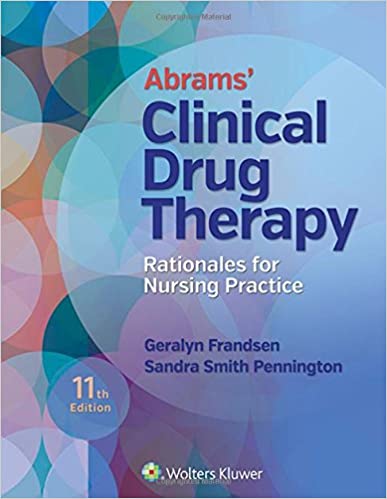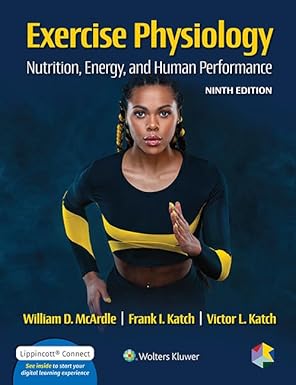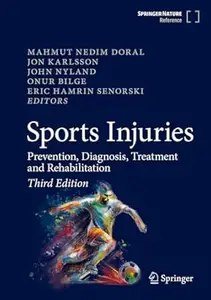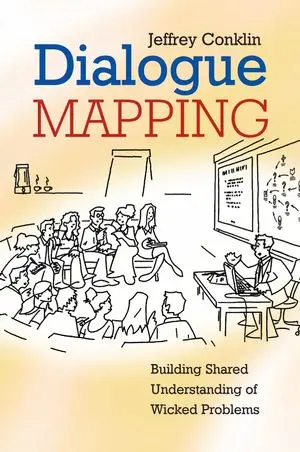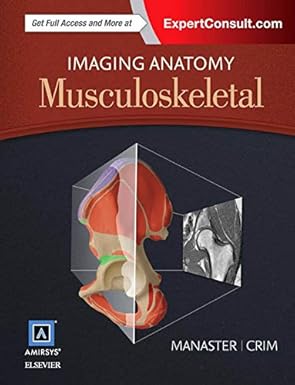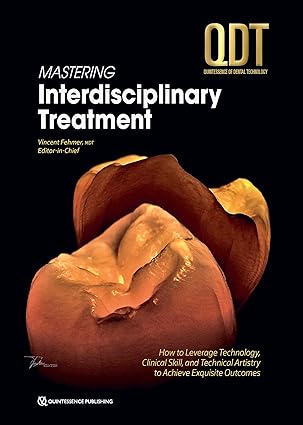Written by expert pharmacology educators and clinicians,
Abrams’ Clinical Drug Therapy has a long tradition of guiding students and instructors through the practice of safe and effective medication administration. Highly praised for its organized and readable presentation, the text explains the "why" behind each nursing action, and emphasizes individualized nursing care and drug therapy. Filled with vibrant illustrations, including new concept maps, the text provides a solid foundation for understanding clinical drug therapy, evidence-based standards for administration, and how to prevent or minimize adverse effects. Complemented with exciting free online resources, the textbook employs innovative features that guide students through the course, while also preparing for success on the NCLEX® Examination and in nursing practice.
Also included is a free copy of
Lippincott's Photo Atlas of Medication Administration , which uses the nursing process format to provide step-by-step nursing skills (with rationales). In addition to being completely illustrated, the
Photo Atlas also contains documentation guidelines and samples, and Unexpected Situations, which explain how to respond to unanticipated outcomes. Topics include removing medication from an ampule, removing medication from a vial, mixing medications from two vials in one syringe, administering an intradermal injection, and more.
KEY FEATURES:
- NEW! Re-visualized Nursing Process includes a concept map to illustrate these guidelines in place of lengthy text
- NEW! Chapter on the Autonomic Nervous System (ANS)
- NEW! More streamlined QSEN Safely Alerts also include knowledge, skills, and attitudes
- NEW! SBAR added to the Clinical Application Feature.
- NEW! Concept Mastery Alerts alert students to commonly misunderstood concepts as derived from our PrepU data
- Learning Objectives summarize what the student should learn while reading the chapter
- A Clinical Application Case Study opens each chapter with a patient-focused clinical scenario
- Black Box Warnings highlight serious life-threatening adverse effects identified by the FDA.
- Evidence-Based Practice boxes provide information about current research and its integration into nursing practice
- NCLEX Success sections interspersed throughout chapters help students prepare for the exam
- Drugs at a Glance Tables summarize the routes and dosage ranges (for adults and children), as well as the pregnancy category, for each drug in the class
- Drug Interactions and Herb and Dietary Interactions boxes highlight the risk of interactions as well as increased or decreased drug effects when drugs are combined with other medications, food, or herbal supplements
- Patient Teaching Guidelines list specific information for the education of the patient and family
- Key terms with definitions help the reader understand chapter content
نوشته شده توسط مربیان و پزشکان متخصص فارماکولوژی،
درمان دارویی بالینی آبرامز دارای سنت طولانی در هدایت دانش آموزان و مربیان از طریق تجویز داروی ایمن و موثر است. متن به دلیل ارائه سازماندهی شده و خواندنی آن بسیار تحسین شده است، "چرا" پشت هر اقدام پرستاری را توضیح می دهد و بر مراقبت های پرستاری فردی و دارو درمانی تاکید می کند. مملو از تصاویر پر جنب و جوش، از جمله نقشه های مفهومی جدید، این متن پایه محکمی برای درک درمان دارویی بالینی، استانداردهای مبتنی بر شواهد برای تجویز، و نحوه پیشگیری یا به حداقل رساندن عوارض جانبی فراهم می کند. همراه با منابع آنلاین رایگان هیجان انگیز، این کتاب درسی از ویژگی های نوآورانه ای استفاده می کند که دانش آموزان را در طول دوره راهنمایی می کند و در عین حال برای موفقیت در آزمون NCLEX® و در عمل پرستاری آماده می شود.
همچنین یک نسخه رایگان از
اطلس عکس لیپینکات مدیریت دارو موجود است که از قالب فرآیند پرستاری برای ارائه مهارت های پرستاری گام به گام (با دلایل منطقی) استفاده می کند.
اطلس عکس علاوه بر اینکه کاملاً مصور است، حاوی دستورالعملها و نمونههای مستند و موقعیتهای غیرمنتظره است که نحوه واکنش به نتایج پیشبینی نشده را توضیح میدهد. موضوعات عبارتند از: خارج کردن دارو از آمپول، خارج کردن دارو از ویال، مخلوط کردن داروها از دو ویال در یک سرنگ، تزریق داخل جلدی و موارد دیگر.
ویژگی های کلیدی:
- جدید! فرایند پرستاری تجسم مجدد شامل یک نقشه مفهومی برای نشان دادن این دستورالعمل ها به جای متن طولانی است
- جدید! فصل در سیستم عصبی خودکار (ANS)
- جدید! هشدارهای ایمن ساده QSEN همچنین شامل دانش، مهارتها و نگرشها میشود
- جدید! SBAR به ویژگی برنامه کاربردی بالینی اضافه شد.
- جدید! هشدارهای تسلط مفهومی به دانشآموزان هشدار میدهد که مفاهیمی که معمولاً اشتباه گرفته میشوند، همانطور که از دادههای PrepU ما گرفته شده است
- اهداف یادگیری خلاصه ای از آنچه دانش آموز باید در حین خواندن فصل یاد بگیرد
- یک مطالعه موردی کاربرد بالینی هر فصل را با یک سناریوی بالینی متمرکز بر بیمار باز می کند
- هشدارهای جعبه سیاه اثرات نامطلوب جدی تهدید کننده زندگی شناسایی شده توسط FDA را برجسته می کند.
- کادرهای
- عمل مبتنی بر شواهد اطلاعاتی را در مورد تحقیقات جاری و ادغام آن در عمل پرستاری ارائه میکنند
- بخشهای
- موفقیت NCLEX که در سرتاسر فصلها پراکنده شده است به دانشآموزان کمک میکند تا برای امتحان آماده شوند
- جدول داروها در یک نگاه مسیرها و محدوده دوز (برای بزرگسالان و کودکان) و همچنین دسته بندی حاملگی را برای هر دارو در کلاس خلاصه می کند
- جعبههای
- تداخلات دارویی و تداخلات گیاهی و غذایی خطر تداخلات و همچنین افزایش یا کاهش اثرات دارو را در صورت ترکیب داروها با سایر داروها، غذاها یا مکملهای گیاهی نشان میدهند
- دستورالعملهای آموزشی به بیمار اطلاعات خاصی را برای آموزش بیمار و خانواده فهرست میکند
- اصطلاحات کلیدی همراه با تعاریف به خواننده کمک می کند تا محتوای فصل را درک کند
